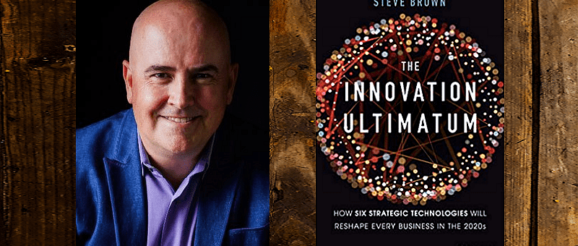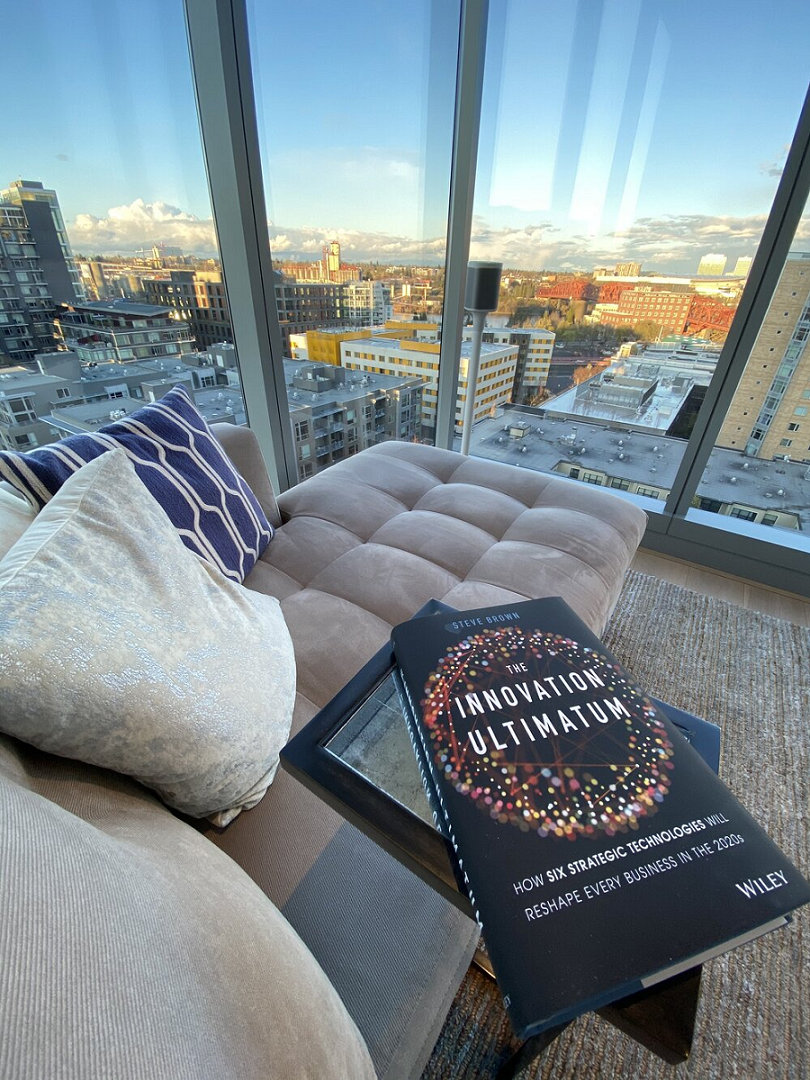How to harness accelerated digital transformation – in conversation with Steve Brown, author, ‘The Innovation Ultimatum’

Steve Brown is the author of The Innovation Ultimatum: How Six Strategic Technologies Will Reshape Every Business in the 2020s.These technologies are artificial intelligence, augmented reality, blockchain, the Internet of Things, 5G networks, and autonomous machines (see my book review here).
The three sections of the must-read book present tech overviews, business responses, and sector scenarios. Entrepreneurs will appreciate the profiles of startups seizing opportunities in this space.
Steve Brown was formerly Futurist and Chief Evangelist at Intel Corporation. He now runs his own consultancy, Possibility and Purpose. Born and educated in the UK, he now lives in Portland, Oregon. On a humorous note, he is also known as the ‘bald futurist.’
See also YourStory’s Book Review section with reviews of over 280 titles on creativity, entrepreneurship, innovation, social enterprise, and digital transformation.
Steve joins us in this chat on digital transformation, responsible AI, and the entrepreneurial mindset.
Edited excerpts from the interview:
YourStory [YS]: In the time since your book was published, what are some notable new tech trends or implementations you have come across?
Steve Brown [SB]: I wrote the book with a ten-year time horizon, so I haven’t seen many new trends not already covered in the book. Since publication, most trends have only accelerated.
One new trend is the increased consumer awareness of the fragility of their lives, their community, and the planet. It feels like COVID sent us all to our room to think about what we had done. It’s been a time of great reflection for many people.
Going forward, consumers are likely to have a heightened concern over health and safety, and will want to learn more about the products they buy and the impact those products have on other people and the environment. Sustainability, ethical sourcing, fair trade, child/forced labour, deforestation, stakeholder capitalism, and circular economy will be words we hear far more in the coming few years.

YS: How has the COVID-19 pandemic affected the findings of your book?
SB: When I wrote the book, I expected most of the things I talk about in it to be implemented within about a decade. The pandemic has accelerated everything. It’s changed the way we think about work. It’s shown us that digital sales channels are more resilient and scale far better than physical ones.
It’s also shown us how digital employee experiences improve resilience and flexibility by enabling remote work. Clients are coming to me and asking how they can implement their long-range 2025 business plans NEXT YEAR.
Digital transformation, automation, and work augmentation efforts are all speeding up. In the book, I say that every company is becoming a technology company, and a data company. COVID-19 has only accelerated that process.
YS: How was your book received?
SB: Generally, very well. I’ve been delighted with all the incredibly positive reviews the book has received. It made all the hard work to research, write, and promote the book all worthwhile.
Fundamentally, I wrote the book to help people. And so far the feedback has been that it’s doing exactly that.
YS: What were some of the unusual responses and reactions you got?
SB: Readers, particularly ones without a technology background, have commented on how accessible they found the book. I believe that when I write about AI, a reader shouldn’t need a technical degree to understand it.
My goal was to help business leaders understand the potential impact of technology on their businesses. I want to empower them to ask the right questions of their suppliers and their IT departments. And I want to inform the casual reader what they might expect from technology in the future (Hint: Flying cars really are coming!).
YS: What is your current field of research?
SB: I’m currently spending my time researching and thinking about the future of work, the future of healthcare, the future of construction, and the future of supply chains, among other things.
YS: There are growing movements around the world for ethical and responsible use of AI. What are some of the core principles that you would advocate for responsible use of the six technologies you describe in your book?
SB: Franklin D Roosevelt, Winston Churchill, and Spiderman have all been credited with some form of the quotation, “With great power comes great responsibility”. The same is true of powerful technologies like artificial intelligence (AI).
These technologies can do amazing good for humanity, or be used for destructive purposes. We should not be afraid of AI, but we should be cautious and careful how we use it. AIs are not programmed, they learn from training data. So, like our children, we need to teach them well if we want them to grow up to be productive members of society, and we should strive for our AIs, like our children, to be better than us.
That means we need to build AIs that aren’t tainted with human bias. Since AIs learn from historical training data that usually reflects human behaviors, we must be careful to extract any source of bias from that data.
For example, an AI that Amazon built to read and prioritise CVs/resumes quickly turned out to be biased against women. That wasn’t the AI’s fault. It was reflecting the historical behavior of Amazon’s hiring managers. Sometimes AI can be a reflection of human behavior, and this led Amazon to shelve the AI and examine its training and hiring practices.
YS: What are the typical challenges innovators face as they scale up their company? How can these challenges be addressed?
SB: As the world becomes increasingly digital, old thinking (developed in the old “physical first” world), can slow innovators down. Companies that embrace “digital-first” thinking, and find ways to take the fullest advantage of digital transformation, will ultimately win in the marketplace – and win BIG.
Innovation laggards face a slow fade into irrelevance. Be willing to spend a higher percentage of your revenue on R&D, IT, and transformation efforts. Focus on short-term wins, and use those gains (in efficiency, new revenue streams, etc.) to fund additional efforts and keep the innovation fly wheel turning.
YS: How should innovators strike that delicate balance between ‘Stick to your vision’ and ‘Adapt to a changed world’?
SB: Mike Tyson famously said, Everybody has a plan until they get punched in the mouth. If your vision is compelling enough, it will survive contact with the reality of the marketplace. But, like Tyson, every company needs to be willing to adapt to the reality of their situation.
Sometimes the world isn’t ready for your grand vision. In which case, you may need to regroup, refocus, and change your ambitions. One trick I’ve seen innovators use is this: if their long term vision isn’t well-received by the market, they bridge towards it with a series of more acceptable, shorter-term visions.
Sometimes, you have to be prepared to move the market one step at a time. Remember, not everyone is necessarily as visionary as you are.
YS: How should innovators evaluate weak signals and anecdotal evidence which seem to contradict quantitative market trends?
SB: All signals are important. Anecdotal evidence should be investigated further and not taken on its own. Sometimes we have stumbled on the tip of a huge iceberg.
Other times it’s just a random blip. We must always keep an open mind and investigate contrarian data points, but don’t throw out pre-existing wisdom for just one or two counter-trend data points without serious further discovery, and beware confirmation bias, in both directions.
YS: Looking outside the US, what do you see as emerging hotspots of tech innovation? How does India fare in this scheme of things?
SB: China has moved from being a country where technology is copied, to a country where tech hardware is efficiently manufactured better than almost anywhere on the planet. They are now moving beyond being a manufacturing powerhouse to become a centre of innovation, particularly in the field of artificial intelligence.
India has this same potential: to move from being an acknowledged centre of excellence for software coding to become a true leader in software-based innovation.
YS: What are the Top Three success factors for government and industry to work together and grow tech innovation in their countries?
SB: Government needs to acknowledge it will never move at the speed of the tech world, but that it needs to move much faster than it does today. The best way to speed government operation is for it to embrace technology itself.
Estonia provides an excellent model. Their government set a goal of making every piece of government digital. This way, people can apply for driving licences online, get visas online, and even vote online.
YS: What is your next book going to be about?
SB: The future of healthcare in 2035.

YS: What is your message to innovators and aspiring entrepreneurs in our audience?
SB: The world needs you more than ever. As I write in the closing chapter of my book, the ‘Innovation Ultimatum’ has two sides to it. The first side of the ultimatum is the obvious business maxim, innovate or die. It speaks to the competitive pressure to innovate and constantly move forwards. Think of that as the stick.
The carrot, the positive incentive to innovate, is the moral imperative. If we can deploy technology to make life better for people, we should – in ways big and small. Technology in the 2020s is exponentially more powerful than the technology we had at our fingertips in the 2000s and even the 2010s.
Artificial intelligence, augmented reality, 5G networks, satellite networks, autonomous vehicles, robots, cobots, drones, blockchain technology, and 100 trillion sensors are the raw building blocks that innovators will use to solve problems that were previously unsolvable.
The world has many problems. It is you, the innovators, change agents, entrepreneurs, and dreamers out there who will use technology to solve problems for people and make the world a better place. Get busy.
YS: Any other parting thoughts or remarks you would like to add?
SB: I am more optimistic about the potential for technology to do good in the world than I have ever been in my more than 30-year career in high tech.
In the coming decade or two, we will revolutionise transportation, supply chains, healthcare, agriculture, construction, manufacturing, finance, and work itself. This is an exciting time to be alive!


